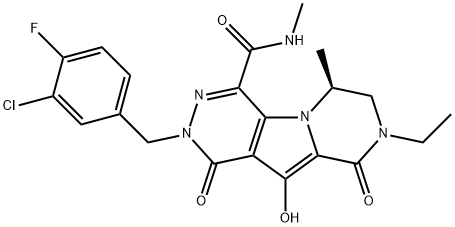Dolutegravir (GSK1349572) , ≥99% , 1051375-16-6
CAS NO.:1051375-16-6
Empirical Formula: C20H19F2N3O5
Molecular Weight: 419.38
MDL number: MFCD20488027
| Pack Size | Price | Stock | Quantity |
| 5MG | RMB446.40 | In Stock |
|
| 10MG | RMB703.20 | In Stock |
|
| 50MG | RMB2194.40 | In Stock |
|
| others | Enquire |
PRODUCT Properties
| Melting point: | 187-189°C |
| Boiling point: | 669.0±55.0 °C(Predicted) |
| Density | 1.53 |
| storage temp. | Refrigerator |
| solubility | DMSO (Slightly, Heated, Sonicated), Methanol (Slightly, Heated, Sonicated) |
| pka | 4.50±1.00(Predicted) |
| form | Solid |
| color | White to Pale Beige |
Description and Uses
In August 2013, the US FDA approved dolutegravir (also referred to as S/GSK1349572) for the treatment of HIV-1 infection in adults and children ages 12 years and older in combination with other antiretroviral drugs. Dolutegravir was approved in Canada in November 2013. HIV/AIDS remains a global epidemic with 35 million people infected, including 2.3 million new infections as of 2012. Dolutegravir joins raltegravir and elvitegravir (this chapter of ARMC) as the latest of three FDA-approved HIV integrase strand transfer inhibitors (INSTIs). Dolutegravir was discovered by rational design from a literature diketo acid HIV integrase inhibitor utilizing X-ray coordinates to predict ideal bond angles between the diketone and distal benzyl group. In dolutegravir, the monocyclic component of the reported inhibitor was replaced with the tricyclic carbamoyl pyridone moiety. The researchers postulated that the appropriate arrangement of three oxygens would permit chelation with two magnesium ions in the binding site thus affording improved potency. Ultimately, this arrangement along with further modifications afforded dolutegravir, a potent inhibitor of HIV integrase (IC50=1.7 nM).
Dolutegravir is a second generation HIV-1 integrase strand transfer inhibitor. Dolutegravir is currently in Phase III clinical trials for the treatment of HIV infection. Dolutegravir has been shown to potently inhibit HIV replication in cells such as peripheral blood mononuclear cells (PBMCs), MT-4 cells and CIP4 cells infected with a self-inactivating PHIV lentiviral vector.
Safety
| Symbol(GHS) |  GHS07 |
| Signal word | Warning |
| Hazard statements | H302-H315-H319-H335 |
| Precautionary statements | P261-P305+P351+P338 |
| Hazardous Substances Data | 1051375-16-6(Hazardous Substances Data) |






